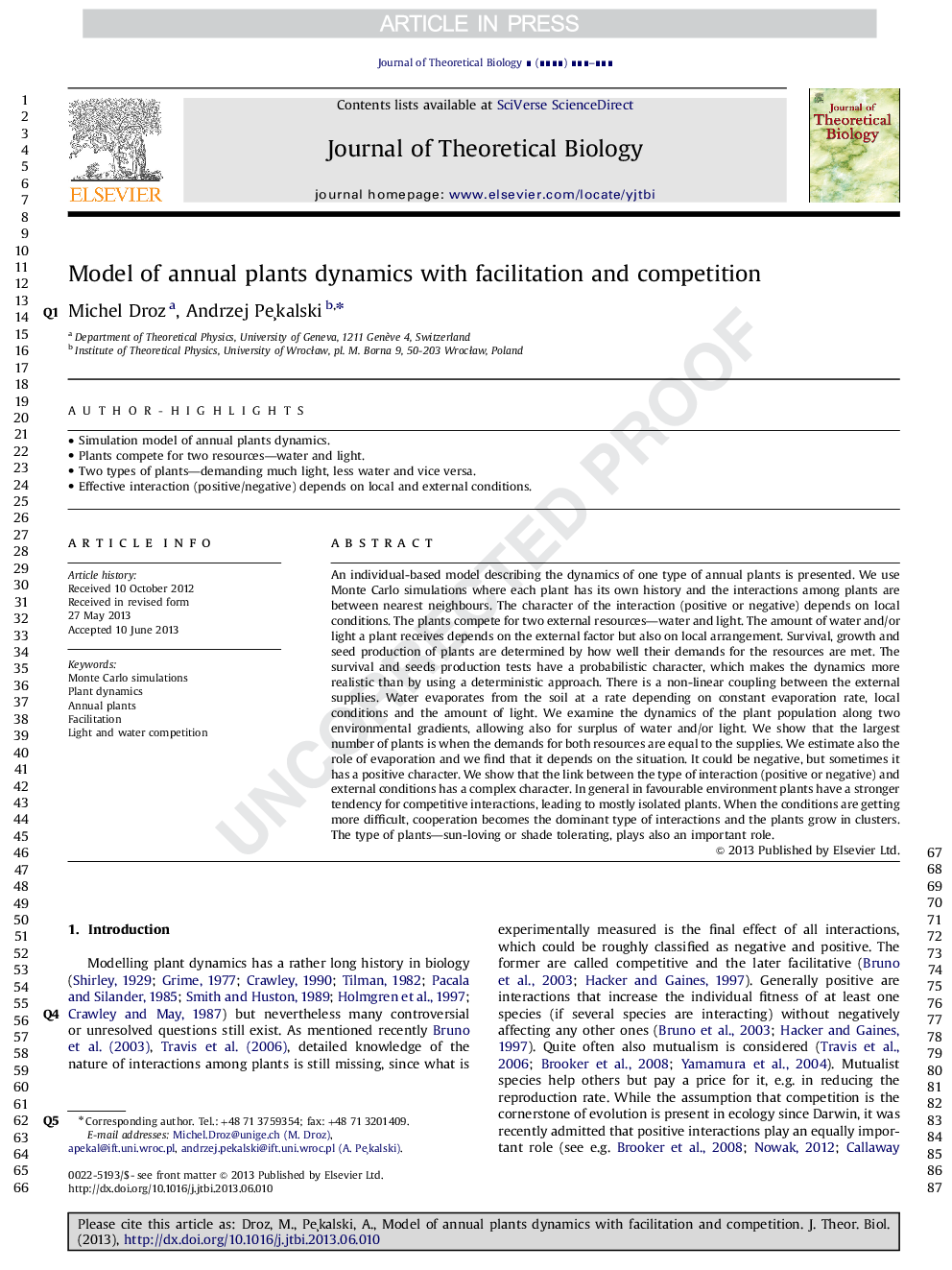| کد مقاله | کد نشریه | سال انتشار | مقاله انگلیسی | نسخه تمام متن |
|---|---|---|---|---|
| 6370668 | 1623875 | 2013 | 12 صفحه PDF | دانلود رایگان |
عنوان انگلیسی مقاله ISI
Model of annual plants dynamics with facilitation and competition
ترجمه فارسی عنوان
مدل دینامیک گیاهان سالانه با تسهیل و رقابت
دانلود مقاله + سفارش ترجمه
دانلود مقاله ISI انگلیسی
رایگان برای ایرانیان
کلمات کلیدی
شبیه سازی مونت کارلو، دینامیک گیاهی، گیاهان سالم، تسهیلات، رقابت نور و آب
ترجمه چکیده
یک مدل مبتنی بر فرد توصیف پویایی یک نوع گیاهان سالانه ارائه شده است. ما از شبیه سازی های مونت کارلو استفاده می کنیم که هر گیاه دارای سابقه شخصی است و تعاملات میان گیاهان بین نزدیک ترین همسایگان است. شخصیت تعامل (مثبت یا منفی) بستگی به شرایط محلی دارد. گیاهان برای دو منبع خارجی آب و نور رقابت می کنند. مقدار آب و / یا نور یک گیاه دریافت می شود بستگی به عامل خارجی، بلکه همچنین در تنظیم محلی. بقا، رشد و تولید بذر گیاهان با توجه به این که چگونه خواسته های آنها در مورد منابع تامین می شود تعیین می شود. آزمایشات زنده ماندن و تولید بذر دارای یک ویژگی احتمالی است که باعث می شود دینامیک واقعی تر از استفاده از رویکرد قطعی باشد. یک اتصال غیر خطی بین منابع خارجی وجود دارد. آب از خاک به سرعت تبخیر می شود بسته به نرخ تبخیر ثابت، شرایط محلی و میزان نور. ما پویایی جمعیت گیاه را با دو شیب محیطی بررسی می کنیم، و همچنین امکان اضافه ماندن آب و / یا نور را بررسی می کنیم. ما نشان می دهیم که بیشترین تعداد گیاهان زمانی است که تقاضا برای هر دو منبع برابر با منابع است. ما همچنین نقش تبخیر را برآورد می کنیم و می بینیم که این بستگی به وضعیت دارد. این می تواند منفی باشد، اما گاهی اوقات شخصیت مثبت دارد. ما نشان می دهیم که پیوند بین نوع تعامل (مثبت یا منفی) و شرایط خارجی یک ویژگی پیچیده دارد. به طور کلی در گیاهان مطلوب گیاهان تمایل بیشتری به تعاملات رقابتی دارند، که منجر به تولید بیشتر گیاهان جدا می شود. هنگامی که شرایط سخت تر می شود، همکاری تبدیل به نوع غالب تعاملات می شود و گیاهان در خوشه ها رشد می کنند. نوع گیاهان تحمل پذیرنده خورشید یا سایه نقش مهمی نیز ایفا می کند.
موضوعات مرتبط
علوم زیستی و بیوفناوری
علوم کشاورزی و بیولوژیک
علوم کشاورزی و بیولوژیک (عمومی)
چکیده انگلیسی
An individual-based model describing the dynamics of one type of annual plants is presented. We use Monte Carlo simulations where each plant has its own history and the interactions among plants are between nearest neighbours. The character of the interaction (positive or negative) depends on local conditions. The plants compete for two external resources-water and light. The amount of water and/or light a plant receives depends on the external factor but also on local arrangement. Survival, growth and seed production of plants are determined by how well their demands for the resources are met. The survival and seeds production tests have a probabilistic character, which makes the dynamics more realistic than by using a deterministic approach. There is a non-linear coupling between the external supplies. Water evaporates from the soil at a rate depending on constant evaporation rate, local conditions and the amount of light. We examine the dynamics of the plant population along two environmental gradients, allowing also for surplus of water and/or light. We show that the largest number of plants is when the demands for both resources are equal to the supplies. We estimate also the role of evaporation and we find that it depends on the situation. It could be negative, but sometimes it has a positive character. We show that the link between the type of interaction (positive or negative) and external conditions has a complex character. In general in favourable environment plants have a stronger tendency for competitive interactions, leading to mostly isolated plants. When the conditions are getting more difficult, cooperation becomes the dominant type of interactions and the plants grow in clusters. The type of plants-sun-loving or shade tolerating, plays also an important role.
ناشر
Database: Elsevier - ScienceDirect (ساینس دایرکت)
Journal: Journal of Theoretical Biology - Volume 335, 21 October 2013, Pages 1-12
Journal: Journal of Theoretical Biology - Volume 335, 21 October 2013, Pages 1-12
نویسندگان
Michel Droz, Andrzej PÈ©kalski,
